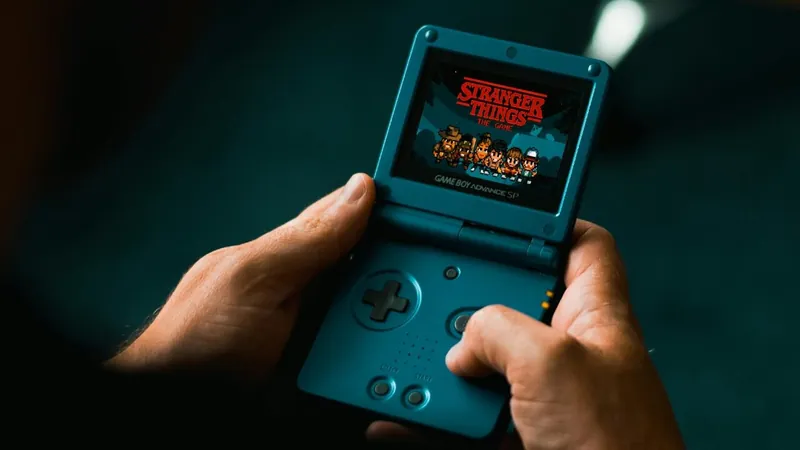
The Retro Gaming Boom: Why Nostalgia is Shaping the Future of Gaming
2025-07-15
Author: William
In a stunning revelation, 26.7 million Americans are regularly diving into the nostalgic worlds of their old-school gaming consoles like the Nintendo Entertainment System, Sega Genesis, and Game Boys. This retro gaming phenomenon translates into a booming global market worth $2.5 billion, growing steadily at a rate of 7-10% annually. But why is this happening?
A Cultural Renaissance in Gaming
It's not just nostalgia driving this trend—it's a broader cultural moment. Retro gaming has become a vital source of joy in our increasingly complex world, where even the simplest games can evoke deep emotional connections. The involvement of former gamers, now with disposable income from their established careers, has proven instrumental in this revival. They’re not just reliving childhood memories; they're actively investing in experiences that resonate with their formative years.
Nostalgia as a Community Catalyst
Nostalgia isn’t merely a personal affair; it fosters community. When enthusiasts gather to reminisce over the sounds of a Game Boy or the frustrations of vintage cartridges, they share a collective experience that cultivates economic value. In North America and Europe, spending on retro gaming is thriving, but the Asia-Pacific region is emerging fast, illustrating the global reach of this gaming culture.
Finding Joy in Simplicity
In an era where modern games require long tutorials and intricate skill trees, the charm of retro games lies in their straightforwardness. Playing Super Mario Bros. can be explained in mere seconds yet remains engrossing decades later. This simplicity stems from early hardware limitations that forced developers to focus on the core essence of gameplay—easy to understand, yet hard to master.
Technological Advances Boost Accessibility
Thanks to modern technological advancements, retro gaming is more accessible than ever. Platforms like Nintendo Switch Online and Xbox Game Pass now offer vast libraries without the need for outdated hardware, while FPGA technology allows for high-fidelity gaming experiences on modern displays. Emulation has shattered regional barriers, making old classics available to audiences worldwide.
How the Past Shapes the Future
For indie developers, retro aesthetics are no longer just a nostalgic nod but a source of innovation. Games like "Shovel Knight" and "Celeste" blend pixel art with modern design craftsmanship. The principles that made early games engaging—tight controls and clear feedback—remain relevant in today’s gaming landscape.
Building a Global Community
Online platforms have transformed the retro gaming community, fostering shared enthusiasm previously absent. Events like speedrunning conventions promote not just competition but also preservation of gaming history. Collectors now seek original cartridges, sparking an investment market that shows no signs of slowing down, despite existing challenges.
A Permanent Shift in Entertainment Values
What we’re witnessing isn’t a fleeting trend; it’s a fundamental shift in how we value entertainment. Retro gaming has proven that technological progression doesn’t diminish the charm of what came before; in fact, it can enhance it. As long as people maintain emotional ties to these experiences, retro gaming will endure.
As we ponder the future, it’s intriguing to consider what the current generation’s gaming experiences will mean for future enthusiasts. The retro gaming phenomenon suggests that true quality transcends time, inviting us to rethink our perceptions of value in an industry focused on the next big hit.









 Brasil (PT)
Brasil (PT)
 Canada (EN)
Canada (EN)
 Chile (ES)
Chile (ES)
 Česko (CS)
Česko (CS)
 대한민국 (KO)
대한민국 (KO)
 España (ES)
España (ES)
 France (FR)
France (FR)
 Hong Kong (EN)
Hong Kong (EN)
 Italia (IT)
Italia (IT)
 日本 (JA)
日本 (JA)
 Magyarország (HU)
Magyarország (HU)
 Norge (NO)
Norge (NO)
 Polska (PL)
Polska (PL)
 Schweiz (DE)
Schweiz (DE)
 Singapore (EN)
Singapore (EN)
 Sverige (SV)
Sverige (SV)
 Suomi (FI)
Suomi (FI)
 Türkiye (TR)
Türkiye (TR)
 الإمارات العربية المتحدة (AR)
الإمارات العربية المتحدة (AR)